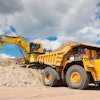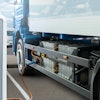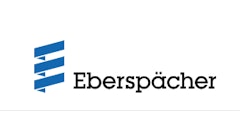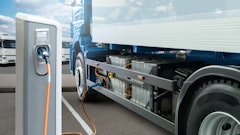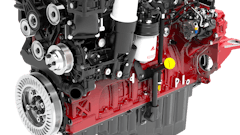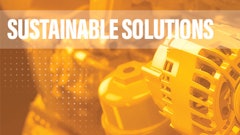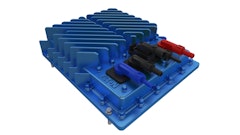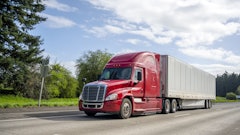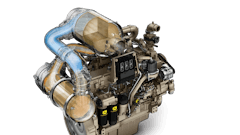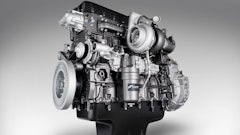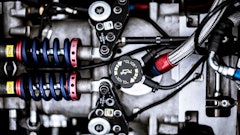Even as off-highway manufacturers adapt to new, clean diesel engines, the push to reduce emissions from existing equipment is gaining momentum. Several state governments, including California, Texas and New Jersey, have implemented retrofit programs, and the federal government is in the process of funding the first year of a five-year national program to help cover the costs of turning older "dirty" diesel equipment into clean machines.
Because diesel engines can last 20 to 30 years, it would take decades to replace existing equipment with low-emission engines. That's too long for regulators, because off-highway equipment is responsible for between 55 and 75% of all particulate emissions. They see equipment retrofits — basically the addition of oxidation catalysts or particulate filters to existing equipment — as an economical way to reduce emissions quickly.
"For cities and states struggling to meet strict new air quality standards, clean diesel retrofit projects have proven themselves to be one of the most cost-effective, immediate solutions for reducing emissions," says Allen Schaeffer, executive director of the Diesel Technology Forum, a trade group that represents manufacturers of engines, fuel and emission control systems.
A cost-efficient solution
It costs about $5,390 to remove one ton of nitrogen oxides (NOx) through retrofits, compared to $126,400 for alternative fuels, according to estimates compiled by the trade group.
Oxidation catalysts use a chemically coated, honeycomb substrate to reduce PM emissions by 20 to 50%, and HC and carbon monoxide (CO) emissions by 60 to 90%. Particulate filters use fiber-wound cartridges, sintered metal or impregnated paper to trap soot particles, effectively reducing PM, HC and CO emissions by up to 90%. NOx emissions can be reduced using exhaust gas recirculation, selective catalytic reduction (SCR) devices and NOx catalysts.
"Oxidation catalysts are definitely the preferred technology for off-highway because they can be a direct muffler replacement," says Joseph Kubsh, executive director of the Manufacturers of Emission Controls Assoc. "They take up the same space and have the same noise attenuation."
While several companies have received regulatory approval for their emission-reduction devices, original equipment manufacturers remain cautious.
"There certainly is a general reluctance out there," says Kubsh. "Some OEMs are gung ho; others are trying to understand all of the ramifications. There are concerns about safety and performance."
Back pressure generated by low-quality or poorly maintained aftermarket components could lower fuel economy and damage engines. Some components may not work without electronically controlled engines or low-sulfur fuel, which will not be available nationwide for another year. In addition, customers and dealers will have to deal with space concerns, especially on smaller equipment.
"Retrofits have to be accommodated in the space that is there, which means some, smaller off-highway equipment is going to be difficult to retrofit," Kubsh says.
The California mandate
It may not be long before fleet owners won't have an option. The California Air Resources Board is considering substantially more stringent guidelines for reducing particulate emissions from existing construction, mining, industrial and airport ground service equipment. It would ban the sale of Tier 0 (pre 1996) equipment, unless it is retrofitted with emission-reducing components. The proposed regulations are intended to help the state meet its aggressive goal of reducing diesel particulate emissions by 75% in the next four years.
The federal government is relying on money instead of regulations to encourage compliance. The Energy Policy Act of 2005, passed last fall, authorizes $1 billion in funding over five years to help fleet owners pay for the cost of retrofits. While the program represents a significant symbolic commitment, funding isn't guaranteed. For 2007, the Bush Administration has only budgeted $50 million in funding, one-fourth the amount authorized by the enacting legislation. Engine manufacturers are hopeful that Congress will set aside more money than the White House requested.
"Voluntary programs to retrofit or replace older diesel engines with new technology can be a very cost-effective way to obtain large-scale national emission reductions," says Jeb Mandel, president of the Engine Manufacturers Assoc. "Voluntary, federally funded programs also offer flexibility to focus efforts where they are needed the most."
Given its national emphasis, the EPA program is likely to be utilized by national, on-highway fleets, as well as contractors that operate in several states. However, approximately 30% of the program's funding will be set aside for state-run retrofit programs, which are still in their infancy.
"Voluntary programs are catching on only to the extent that money is available, and outside of California and Texas that money is small potatoes," Kubsh says.
Interest, however is growing. Last November, New Jersey voters approved a referendum to fund diesel retrofit programs with some of the tax revenue used to pay for cleaning up contaminated sites.
More and more states are using their contracting leverage to promote retrofitting. The latest is Connecticut, which is expected to require "clean air" construction contracts on all projects greater than $5 million. These contracts would require contractors to use equipment equipped either with new, low-emission engines, or older equipment that has been retrofitted with emission-reducing technologies.
The federal government is also helping out here. The U.S. Highway Act of 2005 sets aside $1.5 billion per year for projects designed to reduce congestion or improve air quality. The legislation gives contractors access to Congestion Mitigation and Air Quality Improvement (CMAQ) funding, which will total $8.6 billion over the next five years. Federal highway legislation has included CMAQ funding since the 1990s, but the money has typically been used on entrance/exit ramps, carpooling lanes and mass transit projects.
Because of these financial incentives, and increasing demands for retrofit equipment on state-funded projects, many observers believe that off-highway retrofits will soon gain traction in construction equipment before spreading to other off-highway products. And as clean air requirements force state regulators to find new ways to reduce emissions, OEMs may be forced to adapt to retrofit technologies, whether they like them or not.
Dave Jensen is a contributing editor based in Milwaukee, WI.

